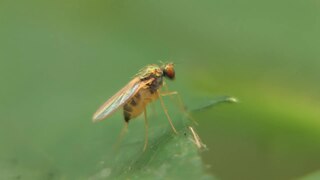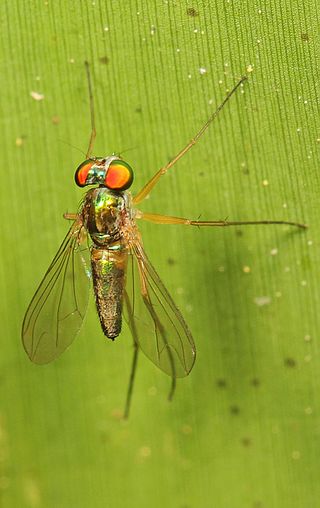
Dolichopodidae, the long-legged flies, are a large, cosmopolitan family of true flies with more than 8,000 described species in about 250 genera. The genus Dolichopus is the most speciose, with some 600 species.

Thrypticus is a genus of long-legged flies in the family Dolichopodidae. There are about 90 described species in Thrypticus. All known larvae of the genus are phytophagous stem-miners of plants in the families Cyperaceae, Poaceae, Juncaceae, and Pontederiaceae. Female adults have a strong, pointed ovipositor used to pierce and insert eggs in the stems of the plants.
Amesorhaga is a genus of flies in the family Dolichopodidae. All species in the genus are from the Oriental realm.
Antyx is a genus of flies in the family Dolichopodidae from the Australasian realm. The genus was originally placed in the subfamily Sympycninae, but it was later found to be closer to the Neurigoninae and was placed as incertae sedis within the family. In the World Catalog of Dolichopodidae by Yang et al. (2006), the new subfamily Antyxinae was proposed, in which Antyx is the only genus. However, the validity of this new subfamily was later criticized by Sinclair et al. (2008). According to them, the subfamily's erection by Yang et al. (2006) was not justified by their phylogenetic analysis, and the genus would have been better placed as incertae sedis until a later phylogenetic study determines its placement.

Chrysotimus is a genus of longlegged flies in the family Dolichopodidae. It is cosmopolitan in distribution, but it is probably paraphyletic with respect to several genera of limited distribution.
Corindia is a genus of flies in the family Dolichopodidae. It is known mainly from the Afrotropical and Australasian realms, with a single species from the Palaearctic realm and an undescribed species also known from the Neotropical realm. The genus was first described in 1986 by Daniel J. Bickel, who originally considered it to be the sister group of the genus Thrypticus. Bickel later suggested that Corindia may represent a plesiomorphic and paraphlyetic assemblage from which Thrypticus arose.
Dolichophorus is a genus of flies in the family Dolichopodidae. It includes eight species distributed in the Palaearctic and Afrotropical realms. The adults have a metallic green, green-black or blue-black body coloring, with some pruinescence.
Dytomyia is a genus of flies in the family Dolichopodidae. It is known from Australia, Madagascar and Kenya, with an undescribed species from Papua New Guinea.
Kowmungia is a genus of flies in the family Dolichopodidae. It is known from Australia.
Narrabeenia is a genus of flies in the family Dolichopodidae, living in Australia and named for Narrabeen, New South Wales.

Sciapus is a genus of long-legged flies in the family Dolichopodidae. There are about 82 described species in Sciapus.

Thinophilus is a genus of flies in the family Dolichopodidae. It includes about 146 described species distributed worldwide. Most species of the genus are found in coastal habitats, while a few species are found in freshwater habitats.

Hydrophorinae is a subfamily of flies in the family Dolichopodidae. Several molecular phylogenetic analyses of the family have found evidence that the subfamily in its current sense is polyphyletic.

Sciapodinae is a subfamily of flies in the family Dolichopodidae. Members of the subfamily possess several ancestral characteristics of the family, such as branched vein M1+2 in the wings (though M2 is absent or reduced in Mesorhagini) and a pedunculate hypopygium. They also typically have a deeply excavated vertex, giving their heads the appearance of a dumbbell when viewed from the front.

Diaphorinae is a subfamily of flies in the family Dolichopodidae.

Medeterinae is a subfamily of flies in the family Dolichopodidae.

Sympycninae is a subfamily of flies in the family Dolichopodidae. In some classifications, this subfamily includes the genera of the subfamilies Peloropeodinae and Xanthochlorinae.

Sciapodini is a tribe of flies in the family Dolichopodidae.

Chrysosomatini is a tribe of flies in the family Dolichopodidae.









